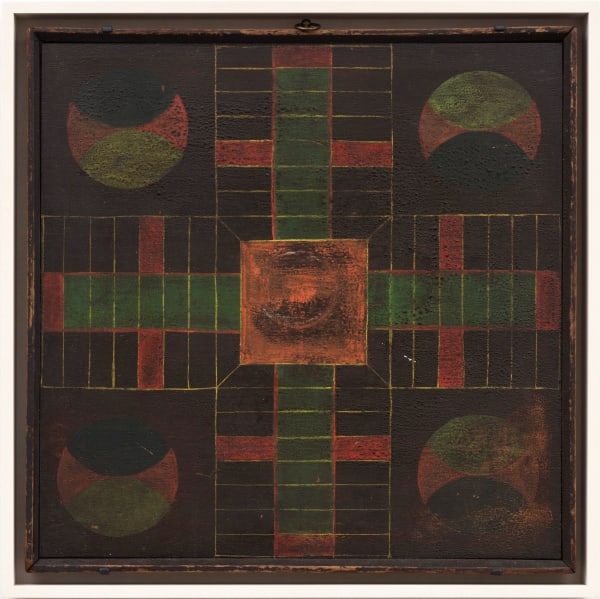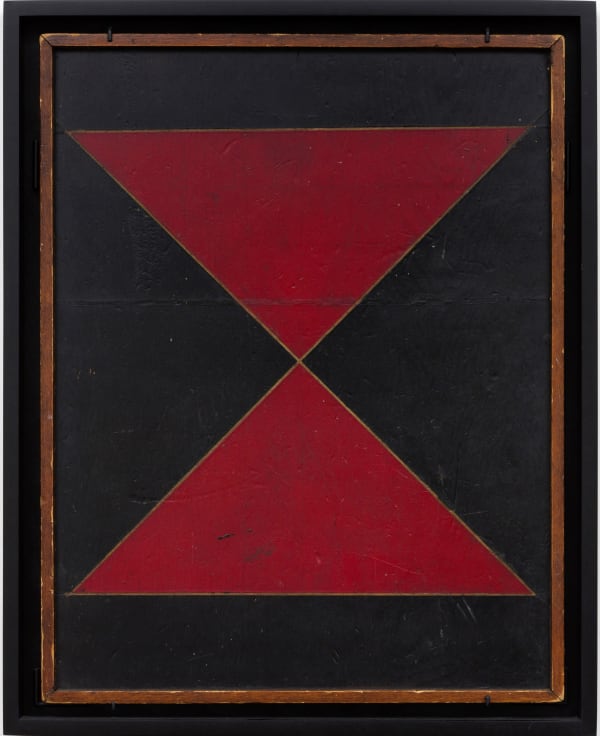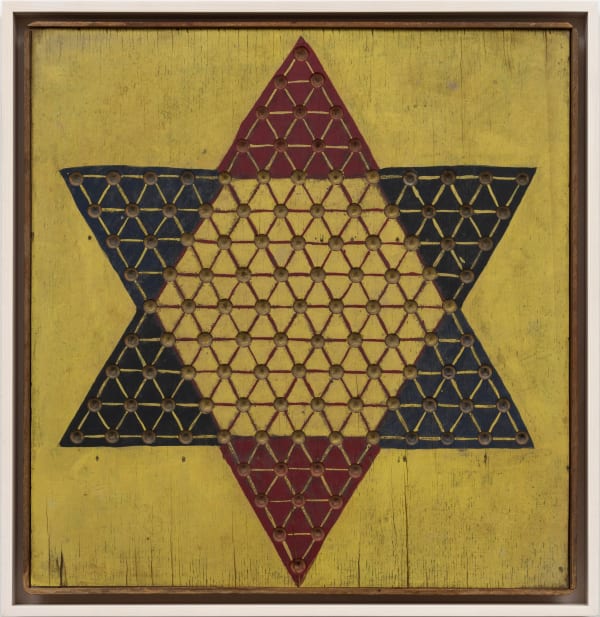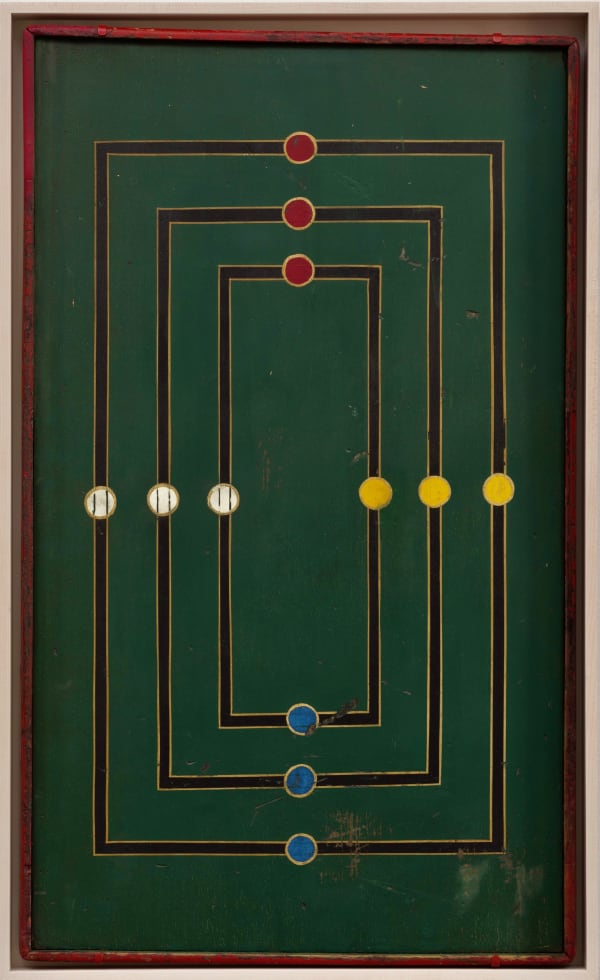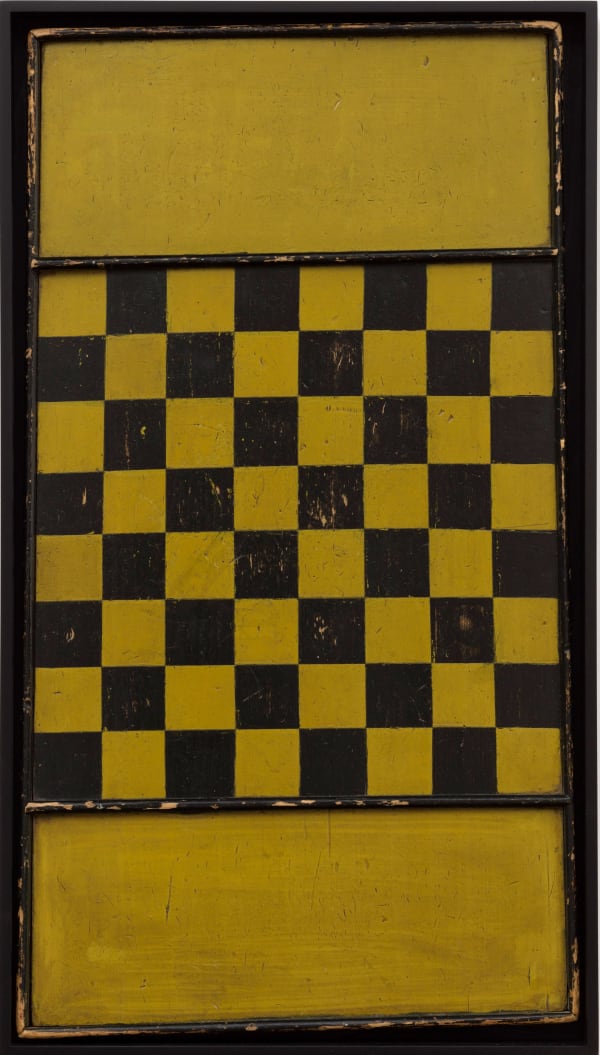-
Including parcheesi, backgammon, checkers,
Chinese checkers, solitaire, and mills boards—all dating from the late 19th through the mid-20th century.
Not created as modern or contemporary art, these game boards relate directly to (and often precede) works of geometric abstraction and minimalism. -
-
 Checkers Game Board, c. 1925-30Polychrome on linoleum board17 3/4 x 13 1/2 in.45 x 34.3 cm.(AU 219)$3,500
Checkers Game Board, c. 1925-30Polychrome on linoleum board17 3/4 x 13 1/2 in.45 x 34.3 cm.(AU 219)$3,500 -
 Parcheesi Game Board, c. 1880-1890Paint on wood panel18 x 18 1/2 in.
Parcheesi Game Board, c. 1880-1890Paint on wood panel18 x 18 1/2 in.
45.7 x 47 cm.(AU 293)SOLD -
 Backgammon Game Board, early 20th centuryOil enamel on wood panel18 x 18 in.
Backgammon Game Board, early 20th centuryOil enamel on wood panel18 x 18 in.
45.7 x 45.7 cm.(AU 260)SOLD -
 Parcheesi Game Board, early 20th centuryOil enamel on wood panel31 x 19 in.
Parcheesi Game Board, early 20th centuryOil enamel on wood panel31 x 19 in.
78.7 x 48.3 cm.(AU 285)SOLD -
 Checkers Game Board with Red Borders, early 20th centuryOil enamel paint on wood panel11 x 14 in.
Checkers Game Board with Red Borders, early 20th centuryOil enamel paint on wood panel11 x 14 in.
27.9 x 35.6 cm.(AU 261)$3,500 -
 Minimal Parcheesi Game Board, late 1940s-early 1950sOil enamel on wood30 x 30 3/4 in.
Minimal Parcheesi Game Board, late 1940s-early 1950sOil enamel on wood30 x 30 3/4 in.
76.2 x 78.1 cm.(AU 291)SOLD -
 Chinese Checkers Game Board, c. 1920-30Light grey wash on wood panel24 1/2 x 23 1/2 in.
Chinese Checkers Game Board, c. 1920-30Light grey wash on wood panel24 1/2 x 23 1/2 in.
62.2 x 59.7 cm.(AU 286)SOLD -
 Solitaire Game Board, c. 1900-1910Joined and carved wood with polychrome11 1/2 x 11 1/2 in.
Solitaire Game Board, c. 1900-1910Joined and carved wood with polychrome11 1/2 x 11 1/2 in.
29.2 x 29.2 cm.(AU 294)SOLD -
 Checkers Game Board, c. 1910-1920Enamel on wood panel16.5 x 22.5 in.41.9 x 57.1 cm.(AU 164)SOLD
Checkers Game Board, c. 1910-1920Enamel on wood panel16.5 x 22.5 in.41.9 x 57.1 cm.(AU 164)SOLD -
 Solitaire Board with Legs and Secret Drawer, late 19th centuryWood with original polychrome10 1/2 x 10 1/2 in.
Solitaire Board with Legs and Secret Drawer, late 19th centuryWood with original polychrome10 1/2 x 10 1/2 in.
26.7 x 26.7 cm.(AU 281)$3,500 -
 Parcheesi Game Board, late 19th - early 20th centuryOil enamel on wood panel17 1/2 x 18 in.
Parcheesi Game Board, late 19th - early 20th centuryOil enamel on wood panel17 1/2 x 18 in.
44.5 x 45.7 cm.(AU 253)SOLD -
 Parcheesi Game Board, late 19th centuryOil enamel on wood panel19 3/4 x 19 3/4 in.
Parcheesi Game Board, late 19th centuryOil enamel on wood panel19 3/4 x 19 3/4 in.
50.2 x 50.2 cm.(AU 241)$4,000 -
 Chinese Checkers Game Board, c. 1930-40Oil enamel on wood panel17 x 17 in.
Chinese Checkers Game Board, c. 1930-40Oil enamel on wood panel17 x 17 in.
43.2 x 43.2 cm.(AU 228)$4,000SOLD -
 Checkers Game Board, late 19th centuryOil based enamel on poplar wood16 1/4 x 16 in.(AU 244)$4,000
Checkers Game Board, late 19th centuryOil based enamel on poplar wood16 1/4 x 16 in.(AU 244)$4,000 -
 Checkers Game Board, late 19th centuryOriginal paint on wood16 1/4 x 16 1/2 in.
Checkers Game Board, late 19th centuryOriginal paint on wood16 1/4 x 16 1/2 in.
41.3 x 41.9 cm.(AU 243)$4,000 -
 Parcheesi Game Board, early 20th centuryWood with original polychrome16 1/2 x 16 1/2 in.(AU 248)SOLD
Parcheesi Game Board, early 20th centuryWood with original polychrome16 1/2 x 16 1/2 in.(AU 248)SOLD -
 Game Board, late 19th centuryOil enamel on wood panel22 3/8 x 18 in.
Game Board, late 19th centuryOil enamel on wood panel22 3/8 x 18 in.
56.8 x 45.7 cm.(AU 284)SOLD -
 Parcheesi Game Board, late 19th - early 20th centuryOil enamel on wood panel19 x 19 in.
Parcheesi Game Board, late 19th - early 20th centuryOil enamel on wood panel19 x 19 in.
48.3 x 48.3 cm.(AU 224)$4,500 -
 Mills Game Board, c. 1910-20Oil enamel on wood panel17 1/4 x 17 1/4 in.(AU 306)SOLD
Mills Game Board, c. 1910-20Oil enamel on wood panel17 1/4 x 17 1/4 in.(AU 306)SOLD -
 Ring Toss Game Board, late 19th centuryWood with polychrome paint, iron nail18 x 18 in.
Ring Toss Game Board, late 19th centuryWood with polychrome paint, iron nail18 x 18 in.
45.7 x 45.7 cm.(AU 283)SOLD -
 Checkers Game Board with Decorative Border, c. 1900Oil enamel on wood panel12 1/2 x 12 1/4 in.
Checkers Game Board with Decorative Border, c. 1900Oil enamel on wood panel12 1/2 x 12 1/4 in.
31.8 x 31.1 cm.(AU 242)$3,500 -
 Chinese Checkers Board, c. 1930-40Oil enamel on wood panel18 1/2 x 17 3/4 in.
Chinese Checkers Board, c. 1930-40Oil enamel on wood panel18 1/2 x 17 3/4 in.
47 x 45.1 cm.(AU 258)SOLD -
 Folding Checkers Board, late 19th-early 20th centuryOil enamel on wood panel14 x 14 in.
Folding Checkers Board, late 19th-early 20th centuryOil enamel on wood panel14 x 14 in.
35.6 x 35.6 cm.(AU 259)SOLD -
 Chinese Checkers Game Board, c. 1930-40Polychorme on wood11 1/2 x 10 1/4 in.
Chinese Checkers Game Board, c. 1930-40Polychorme on wood11 1/2 x 10 1/4 in.
29.2 x 26 cm.(AU 299)SOLD -
 Solitaire Game Board, late 19th century12 3/4 x 12 1/2 in.(AU 307)$4,000
Solitaire Game Board, late 19th century12 3/4 x 12 1/2 in.(AU 307)$4,000 -
 Checkers Game Board, c. 1900-1920Wood with polychrome22 x 18 3/4 in.
Checkers Game Board, c. 1900-1920Wood with polychrome22 x 18 3/4 in.
55.9 x 47.6 cm.(AU 292)$3,000 -
 Mills Game Board, c. 1930-40Paint on wood panel29 x 17 in.
Mills Game Board, c. 1930-40Paint on wood panel29 x 17 in.
73.7 x 43.2 cm.(AU 300)SOLD -
 Plinko Precursor Game Board, first quarter of the 20th centuryOil enamel on wood panel with metal pegs44 x 29 in.(AU 309)SOLD
Plinko Precursor Game Board, first quarter of the 20th centuryOil enamel on wood panel with metal pegs44 x 29 in.(AU 309)SOLD -
 5-Color Checkers Game Board With Blue and Grey Border, late 19th century
5-Color Checkers Game Board With Blue and Grey Border, late 19th century -
 Solitaire Game Board with Pegs , c. 1950s8 5/8 x 8 5/8 in.
Solitaire Game Board with Pegs , c. 1950s8 5/8 x 8 5/8 in.
21.9 x 21.9 cm.(AU 298)SOLD -
 Mills Game Board, late 19th centuryPaint on wood panel25 x 14 in.(AU 303)$4,000
Mills Game Board, late 19th centuryPaint on wood panel25 x 14 in.(AU 303)$4,000 -
 Yellow and Black Checkers Game Board, Late 19th CenturyOil enamel on wood panel31 x 17 in.
Yellow and Black Checkers Game Board, Late 19th CenturyOil enamel on wood panel31 x 17 in.
78.7 x 43.2 cm.(AU 254)SOLD -
 Mills Game Board19 x 15 1/2 in.
Mills Game Board19 x 15 1/2 in.
48.3 x 39.4 cm.(AU 296)$4,000 -
 Wahoo Game Board, c. 1920-3016 1/2 x 16 in.
Wahoo Game Board, c. 1920-3016 1/2 x 16 in.
41.9 x 40.6 cm.(AU 308)SOLD -
 Parcheesi Game Board, c. 1920-30Polychrome on wood21 x 15 in.(AU 310)SOLD
Parcheesi Game Board, c. 1920-30Polychrome on wood21 x 15 in.(AU 310)SOLD
-
-
Aligning with Ricco/Maresca’s ongoing mission to promote the crossover of self-taught, outsider, and vernacular art into the modern and contemporary arenas, Play presents a collection of outstanding game boards made between the late 19th century and the first half of the 20th century. Created as functional objects by unknown American artists, these examples of parcheesi, backgammon, halma, checkers, Chinese checkers, mills, and solitaire have transcended their original purpose and stand on their own as cousins of modern art. This exhibition thus decontextualizes these works to highlight their concrete beauty, but it also acknowledges the mystery and gravitas that they possess as objects that once participated in everyday life.
Modern board games developed as a result of the Industrial Revolution and the emergence of the middle class, but their precursors date back to ancient times—with dice being at the core of humanity’s oldest games. The most prolific and creative period in the American game board tradition falls approximately between 1820 and the end of World War II, when a general period of prosperity and the mainstream availability of new technologies, particularly radio and television, practically eliminated people’s need to fabricate the means to entertain themselves. In the nineteenth century, the majority of game boards were homemade for personal use or produced in domestic workshops for sale within the immediate community—much in the same way as bird decoys, dolls, and quilts. Artists used the materials at hand; easily accessible, generally native hardwoods and standard oil-based household paint—whose durability could withstand the continuous quiet abrasion of the moving parts on the surface.
In the informal environment of a young American nation, artists transformed pre-established patterns into personal compositions, taking creative liberties analogous to jazz—if we think about the framework of the game as a basic melody and of each artist’s visual execution as a kind of musical improvisation. In the best of cases, game boards embody this powerful junction of familiar and new information; of tradition and innovation, with the latter manifesting itself through various degrees of abstraction, deconstruction, and formal embellishment or distillation.
The rhythmic configurations in the square grids of checkers and halma boards; the flat architecture of parcheesi, with its four nests flanking a nucleus and divided by compartmentalized paths; the sharp hypnotic quality of backgammon’s interweaving dagger-like triangles; the harmonious symmetry of the marble-shaped indentations of the hexagram in Chinese checkers and the octagon or cross in solitaire, and the web-like concentric lines in mills offer us—as contemporary viewers—a visual lexicon that is as cohesive and direct as the best works of minimalism and geometric abstraction, which they often precede. Beyond this, a game board’s texture and materiality are equally relevant to its graphic qualities: the surface and “purity” of the object should be a matter of historical significance, a threshold to its former life. Time becomes tangible through scratching from years of touch and play; through the network of cracks (or craquelure) triggered by the shrinkage of the paint and wood, and through the oxidation of the paint after the initial drying phase, which gives the pigments an aged, subdued quality.
Play is Ricco/Maresca’s first exhibition exclusively devoted to an art form that it has been passionately advocating for 40 years. Our hope is that it contributes to bringing vintage American gameboards closer to entering the realm of fine art and further away from the notion of craft. The once marginal understanding of self-taught and outsider artists vis-à-vis the art historical continuum has changed radically in the last few decades, we now recognize them not as extraneous but as essential in the development and ethos of modern art; museums collect and present them. African American quilts have to a certain extent, and more recently, been included in this shift—with museums outside the folk art specialization collecting Gee’s Bend quilts in particular. Exceptional works made by anonymous American game board artists must follow. The preface of Ricco/Maresca’s book American Vernacular expresses it eloquently:
“It has been comfortable for dealers, critics, and collectors to champion this work under constricting labels, almost solely according to concepts of primitivism and authenticity. They set up a simple—and, we believe, spurious—opposition between vernacular and mainstream, art. We call this the ‘glass ceiling’ of folk art, which forever limits its appreciation, understanding, and evaluation … Art is something people do all the time, everywhere, when they need to and when they don’t, when others say it is wrong and when they say it is right … Whether art originated in private pain or in communal vision, it is always excessive. And excess, as William Blake taught, is a form of celebration.”
-
Installation
PLAY: American Game Boards, 1880 -1940: In-Person and Online
Past viewing_room















